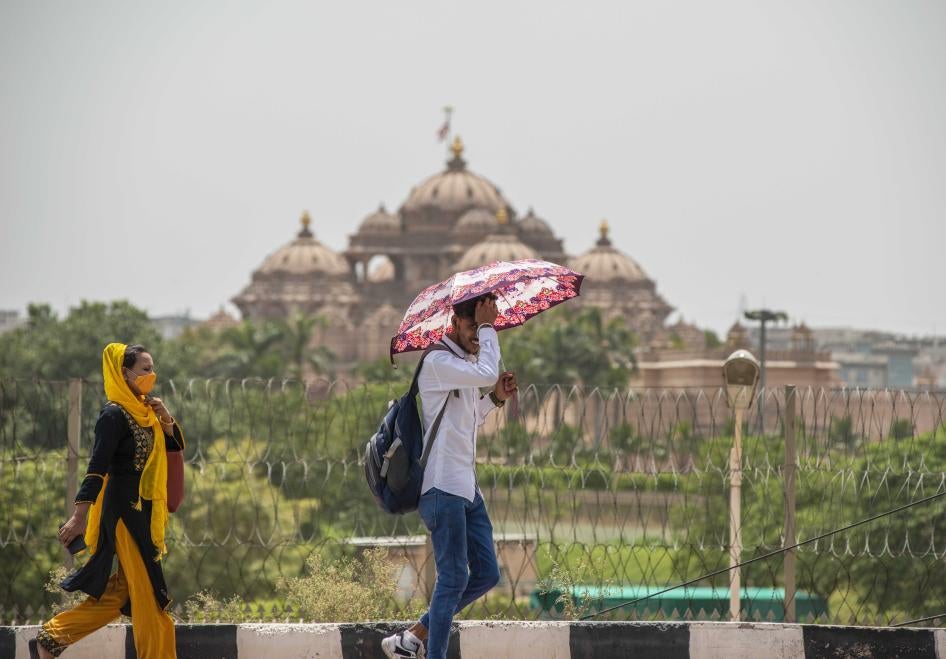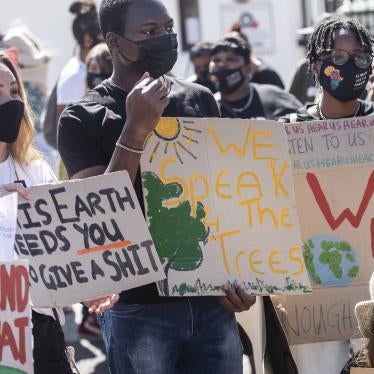(New York) – Governments around the world should act to protect people from the current and foreseeable harms of extreme heat fueled by climate change, Human Rights Watch said today.
Large parts of the globe are currently sweltering in record-breaking temperature extremes. Governments have human rights obligations to help people adapt to the impacts of climate change. This includes an assessment of the foreseeable impact of extreme heat, especially for the populations who are the most at-risk, followed by effective plans to mitigate the expected harm. Governments should also rapidly reduce greenhouse gas emissions and stop subsidizing fossil fuels to prevent the most catastrophic climate outcomes and protect the rights of at-risk populations.
“As temperatures that used to be extreme become more common, and with global temperatures increasing for the foreseeable future, governments should urgently cut emissions and prepare for the already unavoidable consequences of global warming,” said Katharina Rall, senior environment researcher at Human Rights Watch. “Governments should develop clear plans for protecting the rights of people most at-risk and least empowered to protect themselves.”
The world’s leading scientific body on climate change, the Intergovernmental Panel on Climate Change (IPCC), has reported that extreme temperatures are increasing on every continent due to human-caused climate change. This past decade was the hottest on record, and each of the past four decades has been hotter than the one before it because of climate change.
Over 1,000 people have died in the Iberian Peninsula as a result of a searing heat wave making its way across Europe. On July 18, 2022, the United Kingdom announced its first “Red warning” as temperatures in the country hit over 40 degrees Celsius (104 degrees Fahrenheit) for the first time since the government began recording temperatures. People living in Australia, China, France, Germany, India, Italy, Japan, Norway, Pakistan, and the United States have also experienced unprecedented temperature highs this year.
Extreme heat exposure is a serious health hazard. It can cause heat rash, cramps, heat exhaustion, or heat stroke, which can be fatal or have lifelong consequences. Older people, people with disabilities, pregnant people, and children are at increased risk of adverse health impacts from heat, in some cases with fatal consequences.
Human Rights Watch has documented that certain people are exposed to far more heat than others, such as those often doing low-paying work outdoors, or in hot kitchens and warehouses. Weak or inadequate government responses to heat waves also increase the risks for particular populations. Many people, such as those who are living in poverty or otherwise marginalized, are more likely to die or experience heat-related illness because of unequal access to energy or cooling, adequate housing, and water, as well as access to healthcare services. Human Rights Watch research has documented the failure of governments to put in place adequate heat action plans to protect people with disabilities, older people, pregnant people, migrant workers, and those living in poverty.
Climate change makes heat waves longer and more frequent, increasing heat-related mortality. One study published in Nature Climate Change assessed empirical data from 43 countries and found that over a third of heat-related deaths during warm seasons are attributable to climate change. Extreme heat is already having lethal consequences and heat-related mortality–though seriously underreported–is on the rise. Some locations have already reported combined heat and humidity extremes above human limits to survive. Heat is also driving food insecurity and water scarcity, and worsening the impacts of air pollution, which contributes to and compounds mental health conditions, and increases illness.
Even if governments manage “rapid and deep” emissions cuts to meet their human rights obligations and the obligations under the Paris Agreement for holding global warming to 1.5 degrees Celsius above pre-industrial levels, the planet will still experience more intense, more frequent, and longer lasting heat waves across every continent. As many as 30 to 60 million people in the African Sahel region, the Middle East, and South Asia are projected to face average temperatures during the hottest month in their year too high for the human body to function healthily.
The Universal Declaration of Human Rights and the International Covenant on Economic, Social and Cultural Rights provide for the right to health, including the need for governments to respond to foreseeable threats to public health. Government actions to uphold their international human rights obligations to protect people from heat should include the 10 measures below. These recommendations were drafted in consultation with climate, public health, and disaster preparedness experts.
- Assess public health risks of extreme heat. Identify populations most at risk of heat-related death, injury or illness. Identify a threshold at which extreme heat becomes a danger in the region.
- Develop heat mitigation and emergency response plans. Enable meaningful participation of at-risk populations in planning and ensuring capacity to carry out essential measures.
- Implement risk reduction and capacity building policies. Carry out public health campaigns to increase awareness of heat harm targeting at-risk populations, and providing training for first responders, and services or policies to ensure that low-income groups can afford and access cooling solutions.
- Ensure access to water and sanitation, and energy services. Produce clear and public plans to supply or restore water, sanitation, and electricity services (where possible) to areas that lack reliable access. Ensure that services are affordable.
- Ensure that the public is informed of imminent risk and availability of emergency assistance during a heatwave. Ensure that heat advisories are accessible to all populations, including linguistic minorities, people without access to technology, people with disabilities, children, and older people.
- Ensure access to cool environments during a heat wave. Increase access to air conditioning or shaded areas, focusing on at-risk populations. Where possible, provide cooling at government-run and public facilities and institutions, including prisons, schools, healthcare centers, and public transit.
- Ensure safety of outdoor workers. Carry out precautionary measures that may include assessments of heat stress, limiting or changing consecutive outdoor work hours, or requiring that workers take breaks, drink water, and have access to cooler environments for rest.
- Ensure access to medical care and social services for people suffering heat-related health emergencies. In particular, ensure capacity of health systems to handle a surge of heat-related illness during heat waves.
- Continuously monitor the impact of heat and the effectiveness of emergency responses. Seek input from at-risk populations regarding the effectiveness of emergency response measures and needs that were not met. Urgently investigate the full scope of the heat waves, particularly on those most at risk. This includes collecting morbidity and mortality data on the basis of social, economic, and geographic factors.
- Regularly revise and strengthen national and local heat plans. Update heat plans to address problems identified in the post-emergency impact and response assessment.
Governments do not have the same resources to prepare for and address climate impacts on human rights. Lower-income countries, while facing some of the highest risks from climate change exacerbated heat, are also often least equipped to meet these impacts given lack of access to reliable, sustainable energy and limited healthcare services. One assessment based on the UN Environment Programme’s Adaptation Gap Report found that the poorest quarter of the world lags behind the wealthiest in adapting to rising temperatures by about 15 years on average. Increased support from higher emitting developing countries for lower emitting developing countries will be critical for equitable adaptation.
“Talking about heat impacts means talking about preventable death and suffering,” Rall said. “Governments should accept this reality and take steps to meet their human rights obligations to protect people from the current and foreseeable harms of climate change.”








